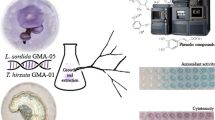Abstract
The nonprotein amino acids 2-amino-3-cyclopropylbutanoic acid and 2-amino-5-chloro-4-pentenoic acid were isolated from the mushroom Amanita cokeri. The cyclopropyl amino acid is toxic to the fungus Cercospora kikuchii, the arthropod Oncopeltus fasciatus (milk weed bug), and the bacteria Agrobacterium tumefaciens, Erwinia amylovora, and Xanthomonas campestris. Toxicity to bacteria was reversible by addition of isoleucine to the medium. No toxicity was observed for 2-amino-5-chloro-4-pentenoic acid.
Similar content being viewed by others
REFERENCES
Chilton, W. S. and Drehmel, D. C. 2001. Cyclopropyl amino acids of Amanita. Biochem. Syst. Ecol. 29:853–855.
Chilton, W. S. and Tsou, G. 1972. A chloro amino acid from Amanita solitaria. Phytochemistry 11:2853–2857.
Chilton, W. S. and Tsou, G. 1973. The unsaturated norleucines of Amanita solitaria: Chemical and pharmacological studies. Lloydia 36:169–173.
Chilton, W. S., Tsou, G., and Kirk, L. 1968. A naturally-occuring allenic amino acid. Tetrahedron Lett. 60: 6283–6284.
Drehmel, D. C., Moncalvo, J. M., and Vilgalys, R. 1999. Molecular phylogeny of Amanita based on large-subunit ribosomal DNA sequences: Implications for taxonomy and character evolution. Mycologia 91:610–618.
Hatanaka, S. 1975. Identification of 2-amino-4,5-hexadienoic acid from Amanita pseudoporphyria Hongo. Lloydia 38:273–274.
Hatanaka, S. I. 1992. Amino acids from mushrooms. Prog. Chem. Org. Nat. Prod. 59:1–139.
Hatanaka, S. and Kawakami, K. 1980. Isolation and identification of L-2-amino-4,5-hexadienoic acid from Amanita neoovoidea. Sci. Pap. Coll. Gen. Educ. Univ. Tokyo 30:147–150.
Hatanaka, S., Kaneko, S., Niimura, Y., Kinoshita, F., and Soma, G. 1974. L-2-Amino-4-chloro-4-pentenoic acid, a new amino acid from Amanita pseudoporphyria. Tetrahedron Lett. 45:3931–3932.
Hatanaka, S., Niimura, Y., and Takishima, K. 1985. Non-protein amino acids of unsaturated norleucine-type in Amanita pseudoporphyria. Trans. Mycol. Soc. Jpn. 26:61–68.
Hatanaka, S., Furukawa, J., Aoki, T., Akatsuka, H., and Nagasawa, E. 1994. (2S)-2-Amino-5-chloro-4-hydroxy-5-hexenoic acid, a newchloro amino acid, and related compounds from Amanitagymnopus. Mycoscience 35:391–394.
Hatanaka, S., Okada, K., and Nagasawa, E. 1995. Isolation and identification of (2S)-2-amino-5-chloro-4-hydroxy-5-hexenoic acid from an Amanita of the section Roanokenses. Mycoscience 36:395–397.
Hatanaka, S., Niimura, Y., Takishima, K., and Sugiyama, J. 1998. (2R)-2-Amino-6-hydroxy-4-hexynoic acid, and related amino acids in the fruiting bodies of Amanita miculifera. Phytochemistry 49:573–578.
Lehninger, A. L. 1975. Biochemistry. Worth Publication, New York, pp. 833–834.
Meek, J. S. and Rowe, J. W. 1955. The synthesis of β-cyclopropyl-α-aminopropionic acid. J. Am. Chem. Soc. 77:6675–6678.
Moncalvo, J. M., Drehmel, D. C., and Vilgalys, R. 2000. Variation in modes and rates of evolution in nuclear and mitochondrial ribosomal DNA in the mushroom genus Amanita: Phylogenetic implications. Mol. Phylogenet. Evol. 16:48–63.
Moriguchi, M., Hara, Y., and Hatanaka, S. 1987. Antibacterial activity of L-2-amino-4-chloro-4-pentenoic acid isolated from Amanita pseudoporphyria Hongo. J. Antibiot. Tokyo 40:904–906.
Ohta, T., Nakajima, S., Sato, Z., Aoki, T., Hatanaka, S., and Nozoe, S. 1986. Cyclopropylalanine, an antifungal amino acid of the mushroom Amanita virgineoides Bas. Chem. Lett. 1986:511–512.
Ohta, T., Nakajima, S., Hatanaka, S., Yamamoto, M., Shimmen, Y., Nishimura, S., Yamaizumi, Z., and Nozoe, S. 1987. A chlorohydrin amino acid from Amanita abrupta. Phytochemistry 26:565–566.
Ohta, T., Matsuda, M., Takahashi, T., Nakajima, S., and Nozoe, S. 1995. (S)-cis-2-Amino-5-chloro-4-pentenoic acid from the fungus Amanita virgineoides. Chem. Pharm. Bull. 43:899–900.
Pelizzari, V., Feifel, E., Rohrmoser, M., Gstraunthaler, G., and Moser, M. 1994. Partial purification and characterization of a toxic component of Amanita smithiana. Mycologia 86:555–560.
Scannell, J. P. and Pruess, D. L. 1975. Naturally occurring amino acid and oligopeptide antimetabolites, in B. Weinstein (ed.), Chemistry and Biochemistry of Amino Acids, Peptides, and Proteins, Vol. 3, pp. 189–244, Marcel Dekker, New York.
Yamaura, Y., Fukuhara, M., Takabatake E., Ito, N., and Hashimoto, T. 1986. Hepatotoxic action of a poisonous mushroom, Amanita abrupta in mice and its toxic component. Toxicology 38:161–173.
Yoshimura, H., Takegami, K., Doe, M., Yamashita, T., Shibata, K., Wakabayashi, K., Soga, K., and Kamisaka, S. 1999. Alpha amino acids from a mushroom, Amanita castanopsidis Hongo, with growth-inhibiting activity. Phytochemistry 52:25–27.
Author information
Authors and Affiliations
Corresponding author
Rights and permissions
About this article
Cite this article
Drehmel, D.C., Chilton, W.S. Characterization and Toxicity of Amanita cokeri Extract. J Chem Ecol 28, 333–341 (2002). https://doi.org/10.1023/A:1017986108720
Issue Date:
DOI: https://doi.org/10.1023/A:1017986108720




